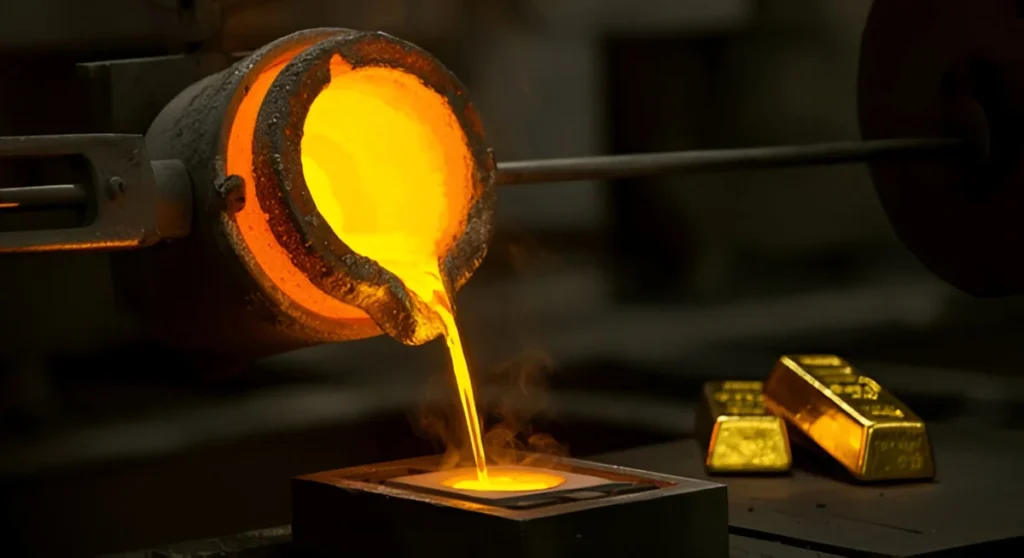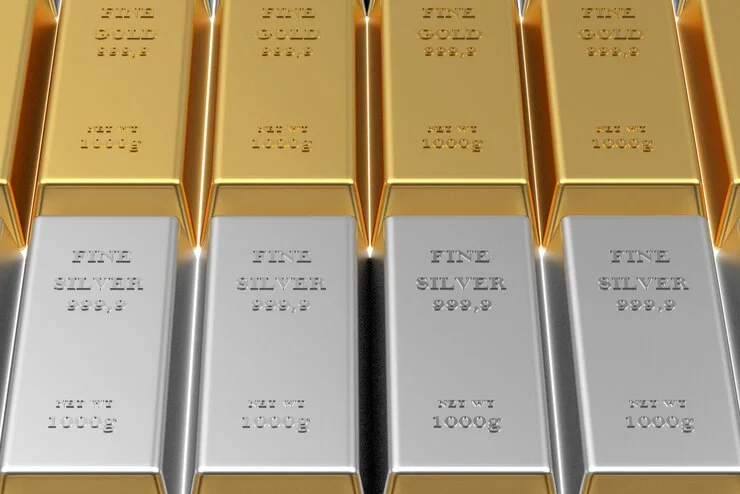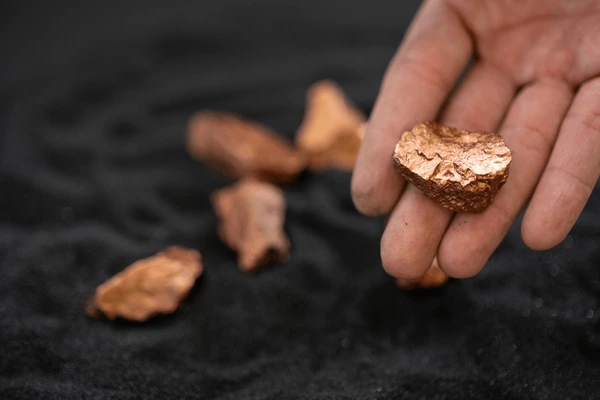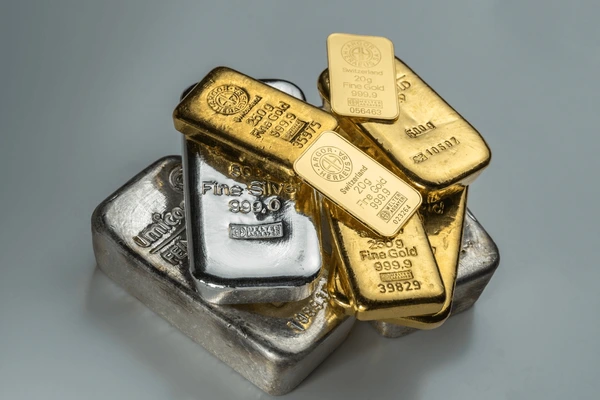Sayanava Sinha Roy
10.10.2025
How Is Silver Refining Different from Gold Refining?
A reputed Gold Buyer explains how silver refining differs from gold refining, covering each process, technique, and benefit in detail to help you understand metal purity and value.
When we think of precious metals, gold and silver immediately come to mind — symbols of beauty, status, and investment. But few truly understand the science and precision behind how these metals achieve their brilliance and purity. Refining is what transforms raw or recycled metal into its purest, most valuable form.
Table of Contents
Though both gold and silver undergo similar stages of purification, the refining process for each metal differs significantly in technique, chemical use, and outcome. Understanding these distinctions not only deepens your appreciation for these timeless materials but also helps you make informed decisions when selling, buying, or investing in precious metals.

The Purpose of Refining Precious Metals
Every piece of jewellery or bullion has impurities. Whether it’s old gold ornaments or tarnished silverware, refining removes unwanted metals, dirt, and residues — leaving behind pure, market-ready metal.
The main goals of refining include:
- Enhancing purity: To achieve standardized quality (99.5% to 99.9% pure metal).
- Ensuring authenticity: To confirm the metal’s composition through hallmarking or assay testing.
- Recycling precious resources: Refining allows old or scrap jewellery to re-enter the economy.
- Maintaining value: Purity directly affects the resale and investment worth of gold and silver.
Both gold and silver refining involve similar objectives — but how they’re achieved varies greatly.
Understanding the Gold Refining Process
Gold refining is one of the oldest metallurgical practices in human history. Over centuries, it has evolved from basic fire techniques to highly scientific processes used by professionals and the Best Gold Buyer in Kolkata today.
Step-by-Step Breakdown of Gold Refining
- Collection and Sorting
Gold materials are collected and categorized based on karat value and condition. Items may include jewellery, coins, or scrap. - Melting and Assaying
The metal is melted in a crucible to create a homogeneous sample. A small portion is then taken for assay testing — to determine the exact gold content before refining begins. - Refining Methods Used
Depending on the desired purity level, different refining techniques are chosen:- Aqua Regia Process: A mixture of nitric and hydrochloric acids dissolves gold, leaving impurities behind.
- Electrolytic Refining: An electric current passes through gold solution, separating pure gold from impurities.
- Miller Process: Chlorine gas is used to purify molten gold, a quick and efficient method used in large-scale refineries.
- Casting and Hallmarking
Once refined, pure gold is cast into bars or sheets and hallmarked to verify its purity before entering the market.
Gold refining emphasises chemical precision and controlled conditions, ensuring minimal metal loss and achieving the highest purity standard.
The Silver Refining Process Explained
While silver shares some refining similarities with gold, its chemistry and behavior require distinct techniques. Silver has a lower melting point and reacts differently with chemicals, making its refining process unique and sometimes more delicate.
Step-by-Step Breakdown of Silver Refining
- Collection and Pre-Treatment
Old silver jewellery, coins, or industrial scrap are gathered and cleaned to remove surface contaminants like dirt, polish, or oils. - Melting and Sampling
The silver is melted in a furnace, and a small sample is extracted to assess purity using methods like spectrometry or cupellation. - Refining Methods Used
Silver refining is generally carried out through two major techniques:- Electrolytic Refining: Silver nitrate solution and electric current are used to separate pure silver from impurities.
- Chemical Refining (Acid Process): A mixture of nitric acid dissolves the silver, followed by precipitation using copper or other agents to recover fine silver.
- Crystallization and Drying
The refined silver is crystallized, washed, and dried, resulting in fine, bright silver crystals of high purity (up to 99.9%). - Forming Bars or Grains
The purified metal is melted again and cast into bars or granules, depending on industrial or ornamental needs.

Key Differences Between Silver and Gold Refining
Although gold and silver share similar refining objectives, their chemical and physical differences demand unique handling techniques. Here’s how the two processes diverge:
| Aspect | Gold Refining | Silver Refining |
|---|---|---|
| Melting Point | Higher (1064°C) | Lower (961°C) |
| Chemical Behavior | Resistant to most acids | Easily reacts with nitric acid |
| Common Methods | Aqua regia, Miller, Electrolysis | Electrolysis, Nitric acid process |
| Recovery Process | Often uses chlorine or acid-based recovery | Uses copper or chemical precipitation |
| Purity Achieved | Up to 99.99% | Up to 99.9% |
| By-products | Silver, platinum traces | Copper, lead residues |
Environmental and Economic Impact
Both gold and silver refining play a key role in sustainability. Recycling old jewellery or industrial scrap reduces mining dependency, conserves natural resources, and minimizes environmental harm.
However, refining must be handled responsibly. Unregulated chemical disposal or unsafe burning methods can release toxins. Ethical refineries use closed-loop systems to ensure zero waste and safe handling of by-products.
For individuals and jewellers alike, choosing professional, environmentally responsible refiners helps ensure both sustainability and fair valuation.
Benefits of Understanding the Refining Process
Knowing how refining works can make you a more confident buyer or seller. Here’s why it matters:
- Transparency: Understanding methods builds trust in where your metal comes from.
- Fair Valuation: Awareness of purity standards ensures you get the best price.
- Sustainability: Encourages recycling rather than mining.
- Investment Clarity: Refined metals are easier to evaluate for resale or trade.
- Protection Against Fraud: Knowing hallmarking and testing methods safeguards you from counterfeit metals.
Why Expertise Matters in Precious Metal Refining
Refining requires not only advanced technology but also precision, ethics, and experience. A professional refinery conducts detailed assays, uses state-of-the-art equipment, and ensures legal compliance with BIS standards.
This expertise ensures:
- Accurate purity analysis
- Maximum recovery of metal
- Safe, environmentally sound operations
- Transparent reporting and hallmark certification
Behind every shining gold bar or polished silver coin lies this careful process of restoration and renewal — a balance of science, skill, and trust.

Frequently Asked Questions
1. Can gold and silver be refined together?
No. Both metals react differently to chemicals, and combining them in refining leads to contamination. They are always refined separately.
2. Is refining old jewellery worth it?
Yes. Refining can recover valuable pure metal from old, damaged, or outdated pieces, often increasing their worth.
3. How often should jewellers refine scrap metal?
Regular refining ensures purity in new designs and prevents impurity accumulation in production.
4. Does refining reduce the weight of gold or silver?
A small loss can occur due to impurity removal, but the resulting metal is far more valuable and pure.
5. How do I verify refined metal purity?
Through hallmarking or laboratory assay reports that confirm the percentage of gold or silver content.
When Precision Meets Purity
Gold and silver refining are more than industrial tasks — they are crafts rooted in accuracy, ethics, and sustainability. While gold’s resilience demands chemical precision, silver’s reactive nature calls for gentle handling and fine control. Both journeys, however, end with a shared goal: purity that reflects true value.
Choosing a refinery with deep expertise — one that values transparency, environmental care, and technology — ensures your precious metals are treated with the respect they deserve.
In the evolving world of precious metal refinement, Rahul Refiners and Analyzer continues to uphold these standards, offering unmatched precision and trustworthiness in every process.
Popular Post



